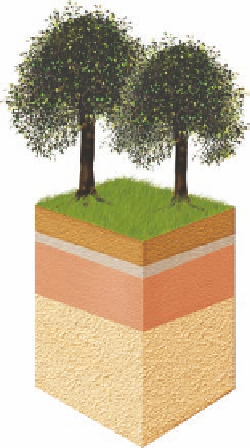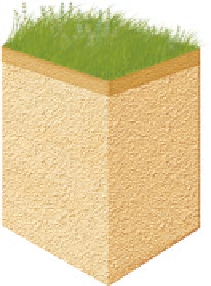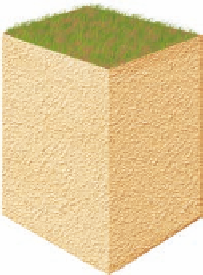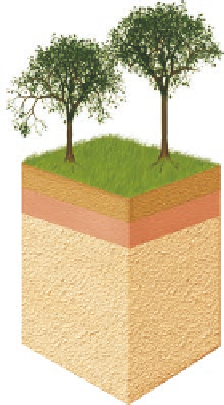Geoscience Reference
In-Depth Information
Time and Soil Evolution
Although the profile in Figure 11.20 is typical, it is far from being
the profile observed in every soil. In fact, not all horizons are
present in every soil. Horizons also vary in color and configura-
tion among different soils. These differences are due not only
to the five soil-forming factors discussed previously, but also to
geographic variability in the way that soil processes function.
To see how soil horizons generally evolve, consider
Figure 11.21. This figure presents the formation of a soil in a
hypothetical profile observed at four separate times: today (0),
500, 1000, and 5000 years into the future. Imagine that “time 0”
begins with the deposition of sediment deposited along a stream
during a big flood. This sediment is thus transported parent mate-
rial within which a soil will form given the additions, transloca-
tions, transformations, and depletions that will ultimately occur.
If you could visit this site at three “future” times, you would
see that the soil evolves in a fairly predictable way. This is not
to say that each soil would change in the same way with respect
to horizon thicknesses or colors or that it would evolve at the
same rate given climate and textural differences. However, the
overall pattern very well could be consistent. Following depo-
sition of the fresh parent material, the first horizon that would
become obvious in the first 500 years or so would likely be the
A horizon. This horizon would develop due to the additions of
organic matter that resulted from the plant and animal life at or
near the surface. (Given your understanding of soil horizons,
what would be the diagnostic characteristic of this horizon?)
At the same time that the A horizon is forming, transloca-
tions and transformations would also be occurring. The cumu-
lative result of these combined processes might begin to be seen
about 1000 years in the future by the development of a Bw hori-
zon immediately beneath the A horizon. The “w” means that
the horizon is weakly developed, and will probably be identi-
fied because the structure has become slightly blocky due to the
illuviation of clays and other minerals at this level of the soil.
Another thing to notice is that the A horizon has become thicker
because of the continual additions that have occurred over the
millennia. It is probably darker as well.
If you returned to examine the soil pit after 5000 years
of development, you might very well discover that a complex
set of horizons had formed. Remember: This development has
occurred because plants, microbes, and animals have been inter-
acting within this soil for a lengthy period of time. In addition,
water has been percolating through the soil for the same length
of time. As a result of these processes operating day by day,
month by month, and year by year for 5000 years, the soil has
a distinctive E horizon and a thick Bt horizon. The E horizon
is the zone of the soil that has been extensively leached of its
mineral and clay components. These minerals and clays moved
downward and recrystallized in the evolving B horizon. In this
A horizon
Fresh
parent
material
C horizon
0 years
500 years
A horizon
A horizon
E horizon
Bw horizon
Bt horizon
Eluviation
C horizon
C horizon
Illuviation
1000 years
5000 years
Figure 11.21 Evolution of a generalized soil profile through time.
In an idealized situation, the development of A, B,
and E horizons might take around 5000 years. Note the progression of horizon development at different periods of time.























